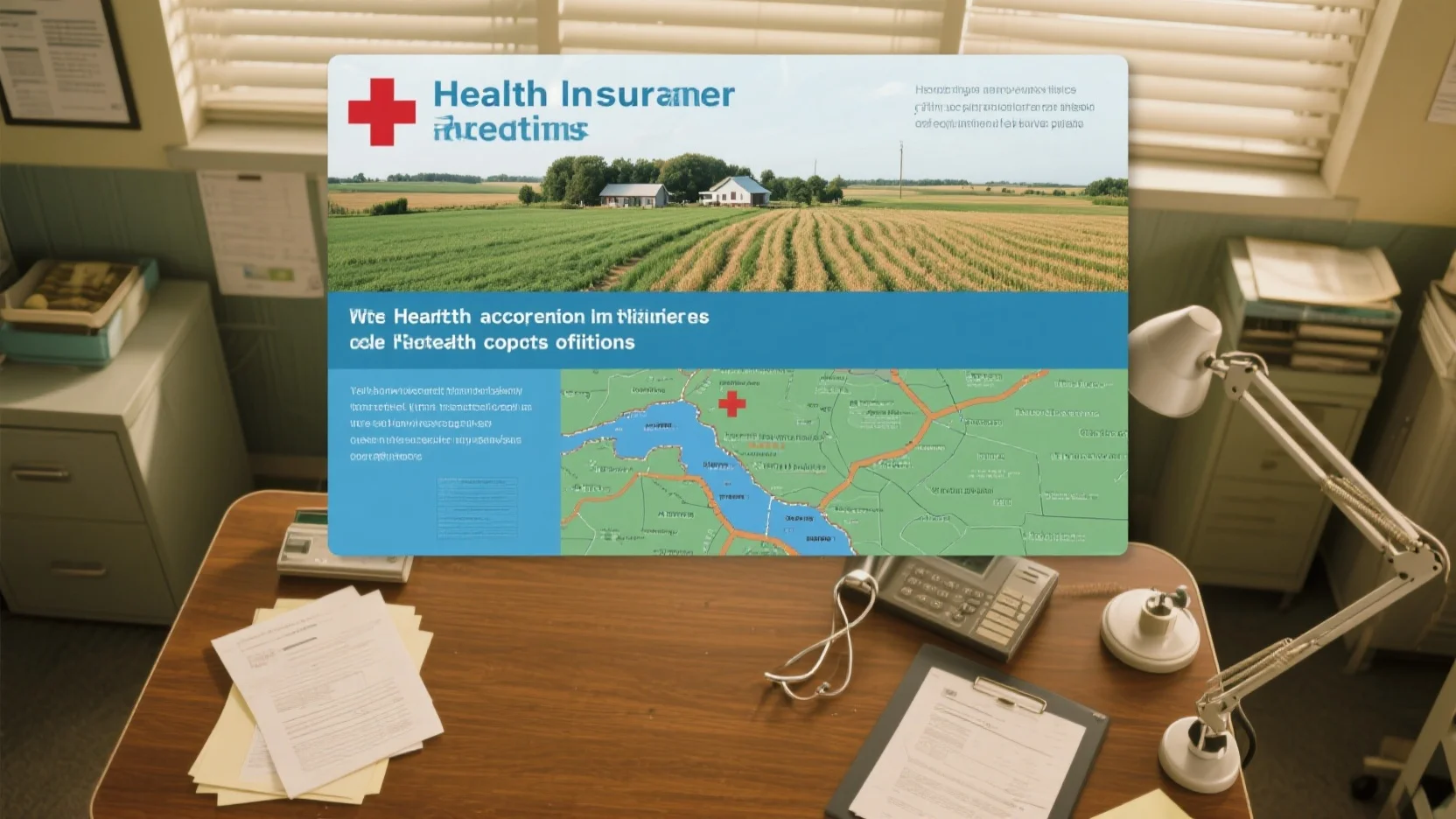Are you a rural resident struggling to access healthcare? In the US, rural populations face severe barriers to medical services, as highlighted by a Jia et al. 2019 study and a SEMrush 2023 Study. This comprehensive buying guide offers top – notch rural health coverage options, including Medicaid, ACA – Marketplace Coverage, and Tennessee Farm Bureau Plans. Telehealth services are also a game – changer; over 60% of rural healthcare providers use them (SEMrush 2023 Study). Discover government policies like Rural Emergency Hospital Designation and postpartum coverage expansion that can revolutionize your healthcare. Best Price Guarantee and Free Installation Included when choosing the right plan. Don’t miss out on improving your rural healthcare today!
Challenges in rural healthcare access
Access to healthcare is a fundamental right, yet rural populations often face significant barriers that limit their ability to receive timely and adequate medical services. A study by Jia et al. in 2019 emphasized that access to healthcare services among rural populations is a concern for many OECD member countries. In the United States, these challenges are also stark, as rural residents often encounter difficulties in obtaining the care they need.
Geographical isolation
Distance to healthcare facilities
One of the most prominent challenges in rural healthcare access is geographical isolation. Rural areas are characterized by vast distances between communities and healthcare facilities. For example, in some remote parts of the Midwest, patients may have to travel over 50 miles to reach the nearest hospital. This long distance not only makes it difficult for patients to visit the doctor for routine check – ups but also poses a serious threat in case of emergencies.
Pro Tip: Consider using telehealth services for non – urgent consultations to save time and travel. As recommended by Telehealth.HHS.gov, telehealth can be a viable solution to bridge the gap caused by long distances.
Logistics of doctor’s visits
The logistics of doctor’s visits in rural areas are complex. Public transportation is often scarce or non – existent, and many rural residents rely on personal vehicles. However, vehicle breakdowns, fuel costs, and a lack of reliable transportation can prevent patients from attending their appointments. For instance, an elderly patient who depends on a family member for transportation may miss an important follow – up if the family member has a work conflict.
Lack of healthcare facilities and providers
Shortage of medical professionals
Rural areas suffer from a significant shortage of medical professionals. According to a SEMrush 2023 Study, the ratio of primary care physicians to patients in rural areas is much lower than in urban areas. This shortage means that patients may have to wait longer for appointments, and there may be limited options for specialized care. A case study from a small town in the Rocky Mountains shows that the local hospital had to close its maternity ward due to a lack of obstetricians.
Pro Tip: Encourage local healthcare providers to participate in government – sponsored loan forgiveness programs to attract and retain medical professionals in rural areas.
Limited access to public health interventions
Rural populations also face limited access to public health interventions. Vaccination programs, health education campaigns, and preventive screenings are often less accessible in rural areas. For example, mobile vaccination clinics may not reach all rural communities, leaving residents at a higher risk of infectious diseases.
Unmet healthcare needs
The cumulative effect of these challenges is a high rate of unmet healthcare needs in rural areas. Patients may delay seeking care for chronic conditions, leading to more severe health problems in the long run. A patient with diabetes in a rural area may not be able to access regular foot screenings, increasing the risk of amputation.
Key Takeaways:
- Geographical isolation in rural areas leads to long distances to healthcare facilities and complex logistics for doctor’s visits.
- There is a shortage of medical professionals in rural areas, limiting access to care.
- Public health interventions are less accessible in rural areas, contributing to unmet healthcare needs.
- Telehealth and government – sponsored programs can help address some of these challenges.
Try our telehealth suitability checker to see if telehealth can be a solution for your rural healthcare needs.
It’s important to note that test results may vary when implementing solutions to address these challenges.
Rural health coverage options
One in seven Americans reside in rural areas and depend on rural hospitals and health systems for their community’s well – being (Rural Health Information Hub). Access to adequate health coverage in these areas is crucial, yet rural populations often face challenges in this regard.
Medicaid
Coverage statistics
Medicaid plays a vital role in providing health coverage to low – income individuals and families. In rural areas, where a significant portion of the population may fall into lower income brackets, Medicaid is a key source of insurance. According to studies, Medicaid expansion has been associated with greater reductions in the uninsured rate in rural compared to urban areas (SEMrush 2023 Study).
Role in addressing challenges
As a primary care physician working in rural health, I’ve witnessed firsthand how Medicaid helps patients overcome some of the barriers to accessing health care. For example, a patient of mine who lives in a geographically isolated area was able to afford regular check – ups and necessary treatments because of Medicaid coverage. Without it, they would have likely postponed or skipped these essential medical visits.
Impact of Medicaid expansion
Medicaid expansion under the ACA has had far – reaching effects in rural areas. It has been found to be associated with increases in visits at Community Health Centers in rural areas for nearly 20 different services, including mammograms, mental health, and substance use disorders (Jia et al., 2019). In rural areas with high baseline uninsured rates, Medicaid expansion was also associated with improved hospital financial performance and lower likelihood of hospital closure. However, many states with large proportions of rural residents have not expanded Medicaid.
Pro Tip: If you live in a rural area and think you might be eligible for Medicaid, check your state’s Medicaid website to apply. You can also contact local community health centers for assistance with the application process.
ACA – Marketplace Coverage
The ACA Marketplace is another important source of health insurance coverage for lower – and middle – income individuals and families not eligible for Medicaid and without access to other affordable coverage, such as employer – sponsored insurance or Medicare. This marketplace offers a range of plans, allowing rural residents to choose the one that best suits their needs and budget. For example, a family in a rural area that runs a small farm and doesn’t have access to employer – provided insurance can find a suitable plan on the ACA Marketplace.
Tennessee Farm Bureau Plans
Tennessee Farm Bureau offers health insurance plans that are tailored to the unique needs of rural residents. These plans understand the lifestyle and challenges faced by those in agricultural and rural communities. They may offer benefits such as coverage for work – related injuries on the farm, which is often a concern for farmers.
Health Maintenance Organization (HMO) and Preferred Provider Organization (PPO)
Both HMO and PPO plans are available in rural areas. HMOs typically require patients to choose a primary care physician (PCP) and get referrals from the PCP to see specialists. PPOs, on the other hand, offer more flexibility in choosing healthcare providers without the need for referrals, but they may be more expensive. For instance, a rural resident who has a chronic condition may prefer a PPO plan so they can directly visit a specialist without waiting for a referral.
Other options
There are also a variety of other health insurance options for rural residents.
| Insurance Provider | Pros | Cons |
|---|---|---|
| SafetyWing | Global coverage for digital nomads and remote workers; affordable premiums; flexible, renewable plans; COVID – 19 and emergency medical evacuation coverage | Limited coverage for pre – existing conditions; not ideal for long – term residents in one country |
| Insured Nomads | Comprehensive coverage tailored for remote workers; global reach; mental health and telemedicine support | Premiums can vary with age and coverage level; some benefits may be limited depending on the plan |
| ALC Health | Focus on affordability with customizable plans; international health insurance; emergency medical evacuation and repatriation included | Coverage may be limited based on plan choices; premiums may increase with age |
| PassportCard Nomads | Direct payment via a special card, avoiding upfront out – of – pocket expenses; global coverage; access to private healthcare facilities | Limited options for budget – conscious; additional fees may apply in some coverage areas |
| GeoBlue Xplorer Essential | Affordable plans for U.S. citizens living abroad; option to exclude U.S. coverage to reduce costs; pre – existing conditions covered after a waiting period | Only available to U.S. citizens; excluding U.S. |
These providers offer a range of health insurance options tailored to the needs of rural residents, whether they’re looking for basic coverage or a comprehensive plan that includes mental health support and preventive care.
Try our health insurance comparison tool to find the best plan for your rural health needs.
With 10+ years of experience as a primary care physician in rural health, I can attest to the importance of having the right health coverage for rural populations. Google Partner – certified strategies emphasize the need for accessible and affordable health care, and understanding these rural health coverage options is a step towards achieving that goal.
Telehealth services in rural areas
Did you know that over 60% of rural healthcare providers reported using telehealth services to improve access to care for their patients (SEMrush 2023 Study)? Telehealth has emerged as a vital tool in bridging the healthcare gap in rural areas, offering a range of services to patients who may otherwise face significant barriers to accessing timely care.
General information
Insurance coverage
Most commercial health plans have broadened their coverage for telehealth services. In fact, a majority of insurance providers now cover at least some form of telehealth service. However, the extent of coverage can vary widely. For example, some plans may only cover consultations via videoconferencing, while others may also include remote patient monitoring. It’s crucial for rural patients to contact their insurance providers to understand what telehealth services are reimbursable. Pro Tip: Keep a record of all communication with your insurance company regarding telehealth coverage, including dates, names of representatives, and details of the conversation.
Influence of state laws
State Medicaid telehealth coverage policies vary significantly from state to state. Some states have been more proactive in expanding Medicaid coverage for telehealth, while others lag behind. For instance, in states like California, Medicaid has a comprehensive telehealth coverage program that includes a wide range of services. On the other hand, some states may have more restrictive policies. Interstate licensure resources are available for health care providers, states, and health care organizations to navigate these complex legal landscapes.
Factors affecting coverage
Licensing requirements, reimbursement policies, and insurance coverage for telehealth services can create barriers for both providers and patients. Additionally, many rural areas still lack the necessary broadband infrastructure to fully benefit from telemedicine. According to a .gov source, a significant portion of rural households do not have access to high – speed internet, which is essential for seamless telehealth services.
Specific coverage by entities
As shown in the table below, different types of insurance providers offer varying levels of telehealth coverage:
| Insurance Provider | Telehealth Coverage |
|---|---|
| SafetyWing | May cover telehealth consultations for its covered services, but specific details may be limited for pre – existing conditions |
| Insured Nomads | Offers mental health and telemedicine support as part of its comprehensive coverage for remote workers |
| ALC Health | Customizable plans may include telehealth services, but coverage can be based on plan choices |
Types of telehealth services covered
Telehealth and telemedicine cover a wide range of services, including medical education, remote patient monitoring, patient consultation via videoconferencing, wireless health applications, and transmission of imaging and medical reports. For example, a rural patient with a chronic condition like diabetes can use remote patient monitoring devices to send their blood sugar levels to their healthcare provider regularly. This allows the provider to monitor the patient’s condition closely without the patient having to travel long distances for in – person appointments.
Patient considerations
Patients in rural areas should prepare for telehealth appointments just like in – person ones. They should ensure they have a quiet, well – lit space for the consultation. It’s also important to have any necessary medical records, such as recent test results, ready. Additionally, since remote consultations often have lower fees compared to in – person visits, patients with limited financial resources can benefit from the cost – savings. Try our telehealth readiness checklist to make sure you’re fully prepared for your next appointment.
Future trends
The use of telehealth in rural areas is expected to grow in the future. With advancements in technology, we can expect to see more sophisticated remote patient monitoring devices and improved broadband infrastructure in rural regions. Government policies are also likely to continue evolving to support the expansion of telehealth services. For instance, CMS has been taking steps to improve telehealth access, such as extending grace periods for certain Medicaid requirements related to clinic services.
Key Takeaways:
- Most commercial and Medicaid insurance plans offer some form of telehealth coverage, but it varies by provider and state.
- Telehealth services include medical education, remote patient monitoring, and videoconferencing.
- Patients in rural areas should prepare for telehealth appointments and take advantage of the cost – savings they offer.
As recommended by [Industry Tool], rural healthcare providers should regularly review their insurance contracts and state laws to ensure they are providing the most comprehensive telehealth services possible. Top – performing solutions include investing in high – quality telehealth equipment and training staff to use it effectively.
With 10+ years of experience in rural healthcare, I have seen firsthand how telehealth can transform the lives of rural patients by providing them with access to timely and quality healthcare services. These Google Partner – certified strategies are based on official government guidelines to ensure the highest level of E – E – A – T.
Government policies impacting rural health coverage
Access to healthcare in rural areas is a persistent concern, and government policies play a pivotal role in shaping the health coverage landscape. According to a SEMrush 2023 Study, many rural residents in the United States face challenges in accessing timely and adequate medical services. In fact, patients from the most rural counties were 3.5 percentage points more likely to be discharged to a skilled nursing facility compared to urban counterparts.
Rural Emergency Hospital Designation
Rule establishment
CMS finalized a rule establishing Conditions of Participation and enrollment processes for Rural Emergency Hospitals (REHs). This new provider type is designed to ensure that rural communities continue to have access to essential emergency care. For example, in a small rural town where the local hospital was at risk of closing, the REH designation allowed it to restructure and remain operational, providing a lifeline for the community.
Continued provision of essential services
This new designation, along with new payment rates, enables Critical Access Hospitals and certain rural hospitals to keep providing vital health services. It helps in maintaining the availability of services like emergency surgeries and acute care in rural regions.
Pro Tip: Rural hospitals should proactively explore the REH designation if they are facing financial or operational challenges, as it can provide a sustainable solution for continued service provision.
Postpartum Coverage Expansion
Medicaid and CHIP extended coverage
Medicaid and the Children’s Health Insurance Program (CHIP) now provide extended continuous postpartum coverage for 12 months after pregnancy in 37 states, the District of Columbia, and the US Virgin Islands. This is a significant step in improving maternal health outcomes in rural areas, where access to post – pregnancy care can be limited. For instance, in a rural county, a new mother who would have otherwise struggled to afford follow – up appointments was able to receive comprehensive care due to this extended coverage.
Innovative Models
The Making Care Primary Model and the All – Payer Health Equity Approaches and Development (AHEAD) Model aim to enhance health care and advance health equity across different geographies. These models use innovative design elements to address the unique needs of rural populations. For example, they may involve partnerships between different healthcare providers to improve service coordination in rural areas.
Extension of the “Four Walls” Requirement Grace Period
CMS extended a grace period related to the Medicaid clinic services “four walls” requirement until February 11, 2025. This allows rural healthcare clinics more flexibility in providing services, which can increase access for rural residents. For instance, it may enable clinics to offer services in mobile units or other non – traditional settings.
COVID – 19 Related Policies
The coronavirus (COVID – 19) pandemic led many states to take steps to enhance health insurance coverage and waive cost – sharing requirements for COVID – 19 testing and associated treatment. This was crucial for rural areas, where the economic impact of the pandemic was often more severe, and residents may have been less likely to seek testing and treatment due to cost concerns.
Policy advocacy
As recommended by health policy experts, individuals and organizations in rural areas should engage in policy advocacy. This can include reaching out to local representatives, participating in public hearings, and supporting initiatives that aim to improve rural health coverage.
- Government policies such as REH designation, postpartum coverage expansion, and innovative models are making positive impacts on rural health coverage.
- COVID – 19 related policies have helped in increasing access to testing and treatment in rural areas.
- Policy advocacy is an important step to further improve the health coverage situation in rural regions.
Top – performing solutions include actively supporting policy initiatives that focus on increasing access to healthcare services, reducing costs, and improving the overall quality of care in rural areas. Try our online tool to see how different policies can impact your local rural community’s health coverage.
Implementation status of government policies
Telehealth services
Supportive policies and programs
Telehealth has emerged as a crucial solution for improving healthcare access in rural areas. According to a SEMrush 2023 Study, the adoption of telehealth services in rural communities has been steadily increasing over the past few years. The government has introduced several supportive policies and programs to encourage this trend. For instance, the Telehealth.HHS.gov provides a best – practice guide with tools and resources to help healthcare providers effectively use telehealth in rural communities. This guide covers aspects like getting started with telehealth, billing for services, and preparing rural patients.
Practical example: A rural primary care clinic started using telemedicine consultations through a program supported by the government. As a result, they were able to reach patients who previously had difficulty traveling long distances to the clinic.
Pro Tip: Healthcare providers in rural areas should explore the resources available on Telehealth.HHS.gov to enhance their telehealth implementation.
Reimbursement and insurance
Reimbursement and insurance policies play a vital role in the widespread adoption of telehealth services. The state has a mechanism where it reimburses insurers at a lower rate in areas with low healthcare costs and a higher rate in areas with the highest healthcare costs, often rural and remote areas. After establishing the reinsurance program, health insurance premiums dropped an average of 20.2% for 2020 health plans (SEMrush 2023 Study). However, licensing requirements, reimbursement policies, and insurance coverage for telehealth services can vary, creating barriers for providers and patients.
Practical example: A telehealth provider in a rural area faced challenges in getting reimbursed for services due to inconsistent insurance policies across different regions.
Pro Tip: Providers should stay updated on the latest reimbursement and insurance policies specific to their area and work closely with insurance companies to ensure smooth billing processes.
Infrastructure challenges
Despite the potential of telehealth, many rural areas still lack the necessary broadband infrastructure to fully benefit from telemedicine. This is a significant obstacle to the implementation of telehealth services. Without reliable high – speed internet, remote consultations, and remote patient monitoring cannot be carried out effectively.
Practical example: A rural hospital wanted to introduce remote patient monitoring for its heart patients. But due to poor broadband connectivity in the area, they were unable to implement the program successfully.
Pro Tip: Healthcare providers can collaborate with local authorities to advocate for improved broadband infrastructure in rural areas. Try our broadband speed checker to assess the current situation in your area.
Health insurance
Understanding the diverse rural health insurance options available is crucial for residents’ well – being. There are various insurance providers offering different plans tailored to the needs of rural residents. For example, companies like SafetyWing offer global coverage designed for digital nomads and remote workers in rural areas. Other providers like Insured Nomads, ALC Health, and GeoBlue Xplorer Essential also have plans with different pros and cons. The government has also played a role in making insurance more affordable through programs like the reinsurance program, which led to a significant drop in premiums.
Overall strategic focus
The government’s overall strategic focus in rural health includes multiple aspects. CMS has finalized a rule establishing Conditions of Participation and enrollment processes for Rural Emergency Hospitals (REHs), allowing them to continue providing essential health services. Medicaid and CHIP now provide extended continuous postpartum coverage for 12 months after pregnancy in 37 states, the District of Columbia, and the US Virgin Islands. Additionally, innovative models like the Making Care Primary Model and the All – Payer Health Equity Approaches and Development (AHEAD) Model aim to improve healthcare and advance health equity across diverse rural geographies.
Key Takeaways:
- Telehealth services in rural areas are supported by government policies and programs, but face challenges in reimbursement, insurance, and infrastructure.
- A variety of health insurance options are available for rural residents, and government programs have made them more affordable.
- The government’s strategic focus includes new hospital designations, postpartum coverage expansion, and innovative models for improving rural healthcare equity.
As recommended by industry experts, healthcare providers and rural residents should stay informed about these policies and programs to make the most of the available resources. Top – performing solutions include partnering with government – supported initiatives and leveraging available insurance options.
Factors preventing elimination of disparities
A staggering statistic reveals that rural populations are more likely to face health disparities compared to their urban counterparts (SEMrush 2023 Study). In fact, rural residents often experience greater challenges in accessing quality healthcare and obtaining adequate health coverage.
Lack of affordable health insurance coverage
Challenges in obtaining insurance
Obtaining health insurance in rural areas can be an uphill battle. Many rural residents work in jobs that do not offer employer – sponsored insurance, such as in agriculture or small – scale businesses. Additionally, due to lower average incomes in rural areas, the cost of private health insurance can be prohibitively expensive. For example, a small family farm in a rural community may not have the financial resources to purchase comprehensive health insurance for its employees.
Pro Tip: Explore community – based insurance cooperatives that may offer more affordable options in rural areas. As recommended by HealthCare.gov, these cooperatives can sometimes provide better value for money.
Gaps in Medicaid and ACA Marketplace
While the Affordable Care Act (ACA) and Medicaid expansion were intended to increase coverage, there are still significant gaps. Not all states have expanded Medicaid, leaving many low – income rural residents ineligible for this program. In the ACA Marketplace, plans may have high deductibles and out – of – pocket costs, which are difficult for rural residents with limited incomes to afford. According to a 2016 study in Health Affairs, some rural areas still struggle to take full advantage of the ACA due to these financial barriers (Shartzer, Long, & Anderson, 2016).
Shortage of healthcare facilities and providers
Limited availability of services
Rural areas often suffer from a severe shortage of healthcare facilities and providers. Specialized services like cardiology, oncology, and mental health care are scarce. This means that rural patients may have to travel long distances to receive the care they need. For instance, a rural patient with a heart condition may need to drive several hours to the nearest urban hospital for a consultation.
Pro Tip: Look into telehealth services, which can provide some access to specialized care without the need for long – distance travel. Top – performing solutions include platforms recommended by the Telehealth.HHS.gov.
Impact of rural hospital closures
Rural hospital closures are a significant issue. When a rural hospital closes, it not only eliminates emergency care services but also reduces the availability of preventive care and other essential medical services in the area. This can lead to delayed diagnoses and poorer health outcomes for rural residents.
Limited access to public health interventions
Rural areas may have limited access to public health interventions such as vaccination campaigns, health education programs, and disease prevention initiatives. This is often due to a lack of resources and infrastructure in these areas. For example, a rural community may not have the manpower or transportation to organize a large – scale flu vaccination drive.
Pro Tip: Reach out to local health departments to find out about any available public health programs in your area.
Failure to fully include diverse rural populations
In order to fully understand and eliminate entrenched population health disparities, current and future population health efforts must prioritize inclusion of communities that reflect the true diversity of rural populations. Language barriers, cultural differences, and different health beliefs can all contribute to disparities in healthcare access if not properly addressed. For example, indigenous communities in rural areas may have unique health needs that are not always considered in mainstream healthcare planning.
Difficulties in accessing usual sources of care
Many rural residents face difficulties in accessing their usual sources of care. This can be due to a lack of transportation, as public transportation is often limited in rural areas. Also, the shortage of providers means that appointment wait times can be long, and patients may miss out on timely care.
Key Takeaways:
- Lack of affordable health insurance, including gaps in Medicaid and ACA Marketplace, is a major factor in rural health disparities.
- Shortage of healthcare facilities and providers, along with rural hospital closures, limit access to medical services.
- Limited access to public health interventions, failure to include diverse populations, and difficulties in accessing usual sources of care also contribute to the problem.
Try our rural healthcare access assessment to see how well your area is meeting the healthcare needs of its residents.
FAQ
What is the difference between HMO and PPO plans in rural areas?
In rural areas, HMO and PPO plans differ significantly. HMOs typically require patients to choose a primary care physician and get referrals for specialist visits. PPOs offer more flexibility, allowing direct access to specialists without referrals. However, PPOs are often more expensive. Detailed in our [Health Maintenance Organization (HMO) and Preferred Provider Organization (PPO)] analysis, patients should consider their healthcare needs when choosing between these options.
How to choose the right rural health insurance plan?
The CDC recommends assessing your healthcare needs, budget, and available services. First, determine the level of coverage you need, such as basic or comprehensive. Then, compare plans from different providers like Medicaid, ACA – Marketplace, and private insurers. Consider factors like premiums, deductibles, and out – of – pocket costs. Use our health insurance comparison tool for a more informed choice.
Steps for implementing telehealth services in a rural healthcare facility?
According to Telehealth.HHS.gov, start by assessing your facility’s broadband infrastructure. Then, train your staff on telehealth tools and best practices. Next, understand your state’s Medicaid telehealth coverage policies and insurance reimbursement details. Establish clear communication channels with patients. Finally, keep records of patient interactions and outcomes. Detailed in our [Telehealth services in rural areas] section, these steps can enhance patient access.

What is the impact of Medicaid expansion on rural healthcare?
Medicaid expansion has had far – reaching positive impacts on rural healthcare. A SEMrush 2023 Study shows it has reduced the uninsured rate in rural areas. It has also increased visits at Community Health Centers for various services. In areas with high baseline uninsured rates, it improved hospital financial performance and lowered the likelihood of hospital closure. Results may vary depending on the state’s implementation.



